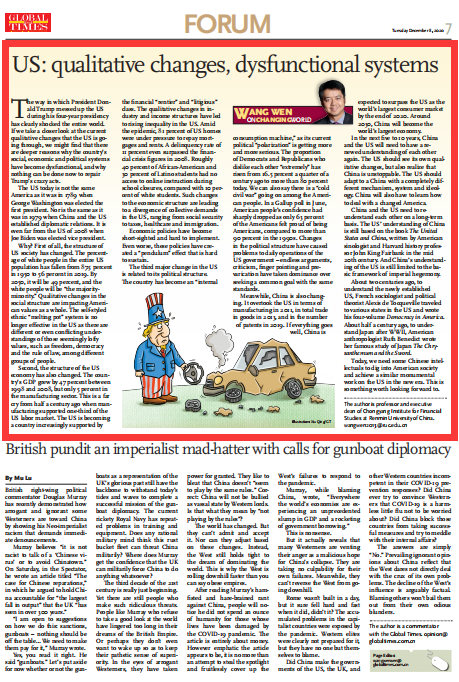Major Power Relations
Your Present Location: PROGRAMS> Major Power RelationsWang Wen: US: qualitative changes, dysfunctional systems
By Wang Wen Source: Global Times Published: 2020-12-7

The way in which President Donald Trump messed up the US during his four-year presidency has clearly shocked the entire world. If we take a closer look at the current qualitative changes that the US is going through, we might find that there are deeper reasons why the country's social, economic and political systems have become dysfunctional, and why nothing can be done now to repair Trump's crazy acts.
The US today is not the same America as it was in 1789 when George Washington was elected the first president. Nor is the same as it was in 1979 when China and the US established diplomatic relations. It is even far from the US of 2008 when Joe Biden was elected vice president.
Why? First of all, the structure of US society has changed. The percentage of white people in the entire US population has fallen from 87.5 percent in 1950 to 56 percent in 2019. By 2050, it will be 49 percent, and the white people will be "the majority-minority." Qualitative changes in the social structure are impacting American values as a whole. The self-styled ethnic "melting pot" system is no longer effective in the US as there are different or even conflicting understandings of those seemingly lofty values, such as freedom, democracy and the rule of law, among different groups of people.
Second, the structure of the US economy has also changed. The country's GDP grew by 47 percent between 1998 and 2008, but only 5 percent in the manufacturing sector. This is a far cry from half a century ago when manufacturing supported one-third of the US labor market. The US is becoming a country increasingly supported by the financial "rentier" and "litigious" class. The qualitative changes in industry and income structures have led to rising inequality in the US. Amid the epidemic, 81 percent of US homes were under pressure to repay mortgages and rents. A delinquency rate of 11 percent even surpassed the financial crisis figures in 2008. Roughly 40 percent of African-American and 30 percent of Latino students had no access to online instruction during school closures, compared with 10 percent of white students. Such changes to the economic structure are leading to a divergence of collective demands in the US, ranging from social security to taxes, healthcare and immigration.
Economic policies have become short-sighted and hard to implement. Even worse, these policies have created a "pendulum" effect that is hard to sustain.
The third major change in the US is related to its political structure. The country has become an "internal consumption machine," as its current political "polarization" is getting more and more serious. The proportion of Democrats and Republicans who dislike each other "extremely" has risen from 16.5 percent a quarter of a century ago to more than 80 percent today. We can also say there is a "cold civil war" going on among the American people. In a Gallup poll in June, American people's confidence had sharply dropped as only 63 percent of the Americans felt proud of being Americans, compared to more than 90 percent in the 1990s. Changes in the political structure have caused problems to daily operations of the US government - endless arguments, criticism, finger pointing and prevarication have taken dominance over seeking a common goal with the same standards.
Meanwhile, China is also changing. It overtook the US in terms of manufacturing in 2011, in total trade in goods in 2013, and in the number of patents in 2019. If everything goes well, China is expected to surpass the US as the world's largest consumer market by the end of 2020. Around 2030, China will become the world's largest economy.
In the next five to 10 years, China and the US will need to have a renewed understanding of each other again. The US should see its own qualitative changes, but also realize that China is unstoppable. The US should adapt to a China with a completely different mechanism, system and ideology. China will also have to learn how to deal with a changed America.
China and the US need to re-understand each other on a long-term basis. The US' understanding of China is still based on the book The United States and China, written by American sinologist and Harvard history professor John King Fairbank in the mid 20th century. And China's understanding of the US is still limited to the basic framework of imperial hegemony.
About two centuries ago, to understand the newly established US, French sociologist and political theorist Alexis de Tocqueville traveled to various states in the US and wrote his four-volume Democracy in America. About half a century ago, to understand Japan after WWII, American anthropologist Ruth Benedict wrote her famous study of Japan The Chrysanthemum and the Sword.
Today, we need some Chinese intellectuals to dig into American society and achieve a similar monumental work on the US in the new era. This is something worth looking forward to.
The author is professor and executive dean of Chongyang Institute for Financial Studies at Renmin University of China. wangwen2013@ruc.edu.cn
Please Find us : Facebook: RDCYINST Twitter: RDCYINST LinkedIn: 人大重阳RDCY Instagram:rdcyinst























































































 京公网安备 11010802037854号
京公网安备 11010802037854号





